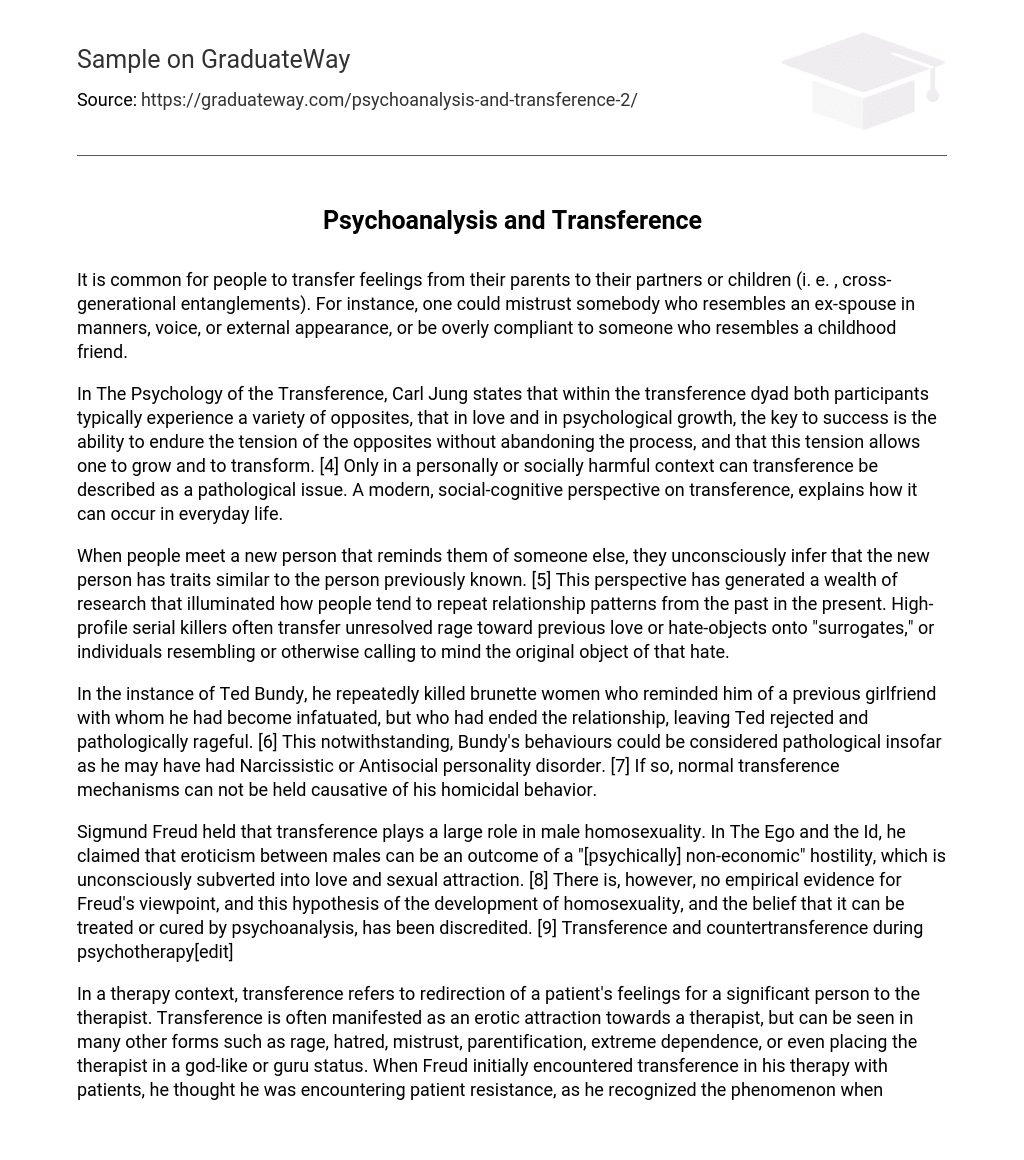Individuals commonly transfer emotions from their parents to their partners or children, called cross-generational entanglements. For instance, someone might feel distrust towards a person who exhibits similar behavior, voice, or physical appearance as their ex-spouse. On the other hand, they may demonstrate excessive compliance towards someone resembling a childhood friend.
According to Carl Jung’s The Psychology of the Transference, when it comes to the transference dynamic, both individuals often experience conflicting elements. Jung believes that in matters of love and psychological growth, successfully handling the tension caused by these opposites without giving up is crucial for personal development and transformation. He also mentions that transference becomes a pathological issue only when it becomes harmful in personal or social contexts. Moreover, social-cognitive psychology offers a modern viewpoint on how transference can manifest in everyday situations.
Research has shown that when people come across someone who looks like a person they have known before, they automatically assume that the new person possesses similar qualities as the previous acquaintance. This has led to extensive studies investigating how individuals tend to recreate relationship dynamics from their past in their current interactions. In the case of prominent serial killers, they often redirect any lingering anger towards past loved ones or enemies onto “surrogates.” These surrogates are individuals who resemble or bring up memories of the original target of their hatred.
Ted Bundy repeatedly killed women with brown hair who reminded him of a previous girlfriend he had become infatuated with. This girlfriend had ended their relationship, leaving Bundy feeling rejected and filled with rage. Nonetheless, Bundy’s actions could be seen as pathological due to the possibility that he had Narcissistic or Antisocial personality disorder. If this is the case, his homicidal behavior cannot be attributed to normal transference mechanisms.
According to Sigmund Freud, transference is significant in male homosexuality. In his work The Ego and the Id, Freud argued that the eroticism experienced between males can result from an unconscious transformation of hostility into love and sexual attraction, which he described as psychologically non-economic. However, there is no factual basis to support Freud’s perspective. This theory regarding the origin of homosexuality and the notion that it is treatable or curable through psychoanalysis has been discredited. Reflection and counterreflection during psychotherapy.
In a therapy context, transference is when a patient redirects their feelings for a significant person to the therapist. Transference can be seen in various forms like erotic attraction, rage, hatred, mistrust, parentification, extreme dependence, or even placing the therapist in a god-like or guru status. Freud initially mistook transference for patient resistance when he observed it during sessions of free association.
However, the analysis of the transference was actually found to be the necessary task according to the findings. In every instance, the transference, whether it was affectionate or hostile, appeared to pose the greatest danger to the treatment, but it actually emerged as the most effective tool. Psychodynamic psychotherapy primarily concentrates on the therapist and patient acknowledging the transference relationship and investigating its significance.
Psychodynamic therapists utilize the transference to uncover unresolved conflicts patients have with childhood figures, as this transference occurs on an unconscious level. Conversely, countertransference is when a therapist redirects their emotions towards a patient or becomes emotionally attached. Recognizing their own countertransference is just as crucial for a therapist as comprehending the transference.
This not only assists therapists in managing their emotions within the therapy relationship but also provides them with valuable understanding of what patients are trying to provoke from them. For instance, if a therapist feels a sexual attraction towards a patient, they must comprehend the countertransference aspect (if present) of this attraction and examine how the patient may be inciting such feelings. Once any countertransference aspect is recognized, the therapist can inquire about the patient’s emotions towards them and investigate how those emotions are connected to unconscious motivations, desires, or fears.
Classical Adlerian psychotherapy presents an alternate viewpoint on transference and countertransference. Instead of strategically utilizing the patient’s transference in therapy, it diplomatically acknowledges and clarifies the positive or negative transference as a hindrance to collaboration and progress. For the therapist, any indications of countertransference indicate the need for further personal training analysis to overcome these inclinations.





